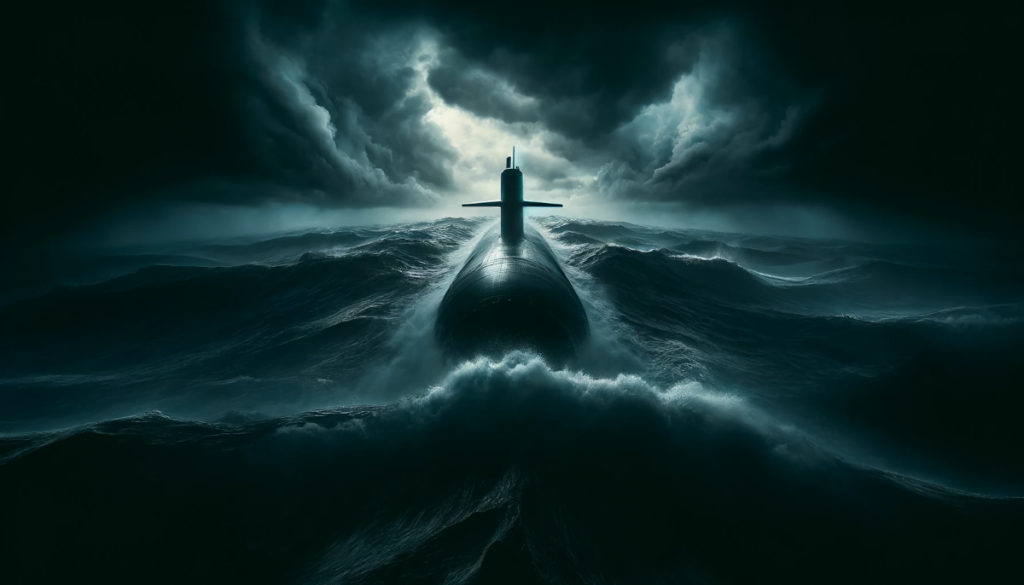
Russian submarine in the Atlantic Ocean (DALL-E)
In a development reminiscent of the Cold War era, U.S. military officials have reported an unprecedented increase in Russian submarine activity in the Atlantic Ocean. This resurgence has raised alarms within the U.S. defense community, emphasizing the need for enhanced maritime security measures. This article delves into the current state of U.S. and Russian submarine operations, strategic implications, and the measures being taken to address this evolving threat.
Increased Russian Submarine Activity
U.S. Army General Chris Cavoli, who oversees NATO and U.S. military operations in Europe, recently testified before the House Armed Services Committee, highlighting the heightened Russian submarine presence. “The Russians have been more active than we’ve seen them in years,” Cavoli stated, noting that their patrols into the Atlantic are at levels not seen since the Cold War.
This increase in activity includes the deployment of 11 nuclear-powered submarines, showcasing Russia’s advanced naval capabilities. These submarines are not only patrolling the Atlantic but are also active in the Mediterranean and around European waters, posing a significant challenge to U.S. and NATO naval forces.
Strategic Implications and U.S. Response
The resurgence of Russian naval operations in the Atlantic has prompted the U.S. Navy to bolster its anti-submarine warfare capabilities. The establishment of dedicated undersea warfare commands and the execution of enhanced anti-submarine exercises, such as the Black Widow training operation, are crucial steps in countering the Russian threat. These exercises focus on refining tactics, techniques, and procedures to effectively locate and neutralize undersea threats posed by advanced Russian submarines.
Assistant Secretary of Defense for International Security Affairs, Celeste Wallander, also emphasized the continued strategic threat posed by Russia, despite the attrition of its forces in Ukraine. “Russia retains strategic capabilities: an air force, cyber, and underwater. We should not underestimate Russia’s military capabilities,” Wallander warned.
NATO’s Enhanced Maritime Security
The integration of Finland and the potential accession of Sweden into NATO are significant developments that enhance the alliance’s maritime security capabilities. Finland brings a competent navy and a large, growing air force, while Sweden’s active and powerful navy in the Baltic Sea area will provide substantial additional capability to control the northern regions. These additions are expected to significantly bolster NATO’s ability to monitor and manage undersea threats.
Russian Naval Strategy and Capabilities
Russia’s naval strategy has historically focused on maintaining a robust submarine force capable of projecting power and conducting strategic deterrence. The recent increase in submarine patrols is part of Russia’s broader strategy to assert its presence in critical maritime regions and challenge U.S. and NATO dominance. Russian submarines are equipped with advanced stealth technologies, making them difficult to detect and track, thereby increasing the complexity of anti-submarine warfare operations for the U.S. and its allies.
Global Strategic Environment
The heightened submarine activity in the Atlantic is occurring against a backdrop of increased geopolitical tensions between Russia and the West. The ongoing conflict in Ukraine has strained relations and heightened the risk of direct confrontation. The U.S. and its NATO allies are therefore compelled to maintain a high level of readiness and deterrence in the face of these evolving threats.
The increased presence and sophistication of Russian submarines in the Atlantic represent a significant shift in the undersea warfare landscape. This development necessitates continued vigilance and cooperation among U.S. and NATO forces to ensure maritime security and readiness. As geopolitical tensions persist, the strategic importance of maintaining robust anti-submarine capabilities cannot be overstated.








